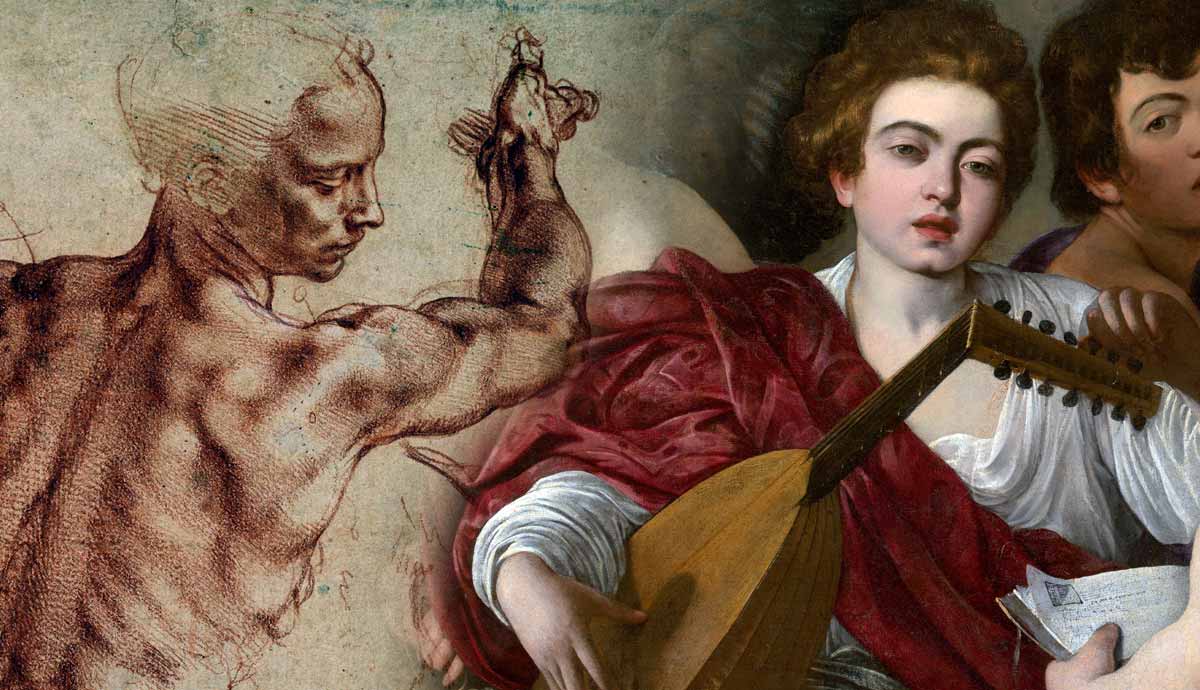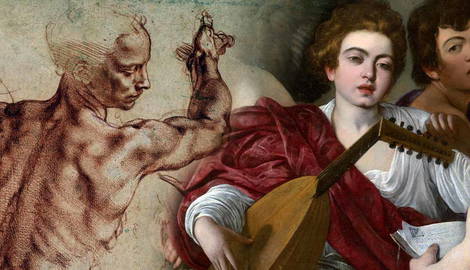
The Renaissance was a period of innovations and intellectualism, where artists and patrons of the art world both shared and debated new ideas and concepts. The debate of colorito versus disegno emerged in the 16th century in Florence and Venice, with Florentine artists prioritizing the design, or disegno, and Venetian artists heralding colorito, or color. Due to the complexity of the two concepts, which are fundamental parts of the artistic process, the debate impacted Renaissance art greatly. This article will show the implications of one of the most famous Italian paragoni.
The Origins of Colorito and Disegno

The paragone (comparison) between colorito and disegno originates in 16th-century Italy. The debate was popularized by two of the most influential cities of Renaissance Italy, Florence and Venice. Venice was a powerful city because of its extensive commerce relations and its history as a city under Byzantine rule. The Byzantine influence of Venice put its mark on the city’s taste in art and architecture. This translated into a predilection for colorful art pieces, as colorfulness played a primordial role in Byzantine art.
On the other hand, Florence was seen as the birthplace of the Renaissance movement. The city was known for being ruled de facto by influential and wealthy merchant families. Some of the oldest families had made their fortune through the wool trade and then invested their resources in politics and art, boosting the renown of Florence.
This difference in heritage and context influenced the two cities’ views on art. The artists of Florence searched for inspiration in the new theory of humanism and the art order of Antiquity. Because of this, Florentine artists favored disegno over colorito, seeing it as the most important element in the artistic creation process. The Venetian artists, with their Byzantine influence, favored colorito as it was seen as a lasting heritage of the Byzantine Empire.
What Exactly Is Colorito?

The ultimate goal of Renaissance artists was to represent nature as closely as possible; how to do this, however, was hotly debated. In response to this ideal, Venetian artists theorized that the correct application of color, particularly the use of tones and shading, would allow the artist to imitate nature perfectly.
Colorito, thus, refers to the importance of color for an artistic composition. Those who favored colorito believed that applying the right color was the most important step in achieving a masterpiece that could live up to the mastery of the ancients. Favoring color in Venice was, as mentioned before, influenced by Venice’s connection to the Byzantine Empire. Besides this, the colorito approach was most likely also boosted by the Venetian trade in color pigments, which enabled artists to experiment with bold colors. Another possible factor for this choice can be found in the climate of Venice. Because it’s surrounded by water, the air is damp, and this made artists favor oil painting over frescoes, as the former was more durable in this context.
Color was deeply influenced by light, so the play of light and shadow offered a realistic aspect to the painted object, making it appear as if it existed before our eyes. This belief was reflected in the works of the Venetian School of painting, which perfected its technique of color blending and color layering to obtain a rich and vivid work of art. Color was thus seen as the most essential part of the process of imitating nature and tricking the human eye.
What Exactly Is Disegno?

As opposed to Venetian artists, Florentine masters regarded disegno as the most critical component in a work of art. Disegno stood for both drawing and design, as they believed that the concept of disegno, translated as design, was the embodiment of all art. No art form could be brought to life without the element of design being accomplished first. Because of this unifying aspect, disegno was regarded by Florentine artists as the most fundamental concept for artistic creation, as opposed to color.
In the arts, the design of a work manifests itself best through a good drawing. That is why, when forming artists, Florence greatly emphasized the apprentices’ mastery of drawing. Without being an accomplished draftsman, an artist could never achieve the greatness of the ancients and the likeness of nature.
This belief in the importance of design and drawing greatly influenced the Florentine attitude toward what counts as valuable in the art market. The appreciation of drawing resulted in significant interest in preserving drawings and keeping and storing them carefully. They were also sold to prospective buyers or patrons who treasured them. The creation process of painters was impacted by the importance of disegno through the more frequent use of preparatory sketches, studies, and cartoons, which helped ensure the quality of the final product. Needless to say, by creating so much secondary artistic material, the material heritage of great masterpieces was preserved.
Intellect vs. Emotion: Why Is This Distinction Important?

The distinction between disegno and colorito is important because it encompasses the two theoretical pillars of Renaissance art. Despite their differences, it can be argued today that both are essential to the artistic process, as both followers of disegno and colorito had to employ both techniques of coloring and drawing/designing. The two concepts were also differentiated by the philosophy that developed behind each of them. In the case of colorito, art theorists associated the act of coloring with emotion and the artist’s capacity to represent it. The emotion of the scene would dictate the visual intensity of the colors. A tragic scene would have starker coloring with stronger contrast, while a happy scene would be radiant and lighthearted.
In the case of disegno, art theorists connected it to intellect and rationality because of its association with the many preparations required to create an artwork. Disegno was seen as directly associated with rationality because both design and drawing were calculations of the mind. The mind had to try various versions and “think” on paper before the final product could be completed. The designing of scenes also implied the use of multiple lines, which were calculated in such a way as to produce perspective and depth to the work.
Fundamentally, under the influence of humanism, the two sides of the debate were connected to the larger philosophical debate between rationality and the senses, which had been going on since Antiquity.
Who Supported Colorito & Who Supported Disegno?

For such a debate to become important in Renaissance cultural life, artists were joined by writers who weighed on this problem. On the side of colorito, the writers Pietro Arentino, Lodovico Dolce, Paolo Pino, and Marco Boschini argued in favor of emotion and color as the most important elements of the creation process.
On the other side, the famous writer Giorgio Vasari, followed by Frederico Zuccaro, Giovanni Pietro Bellori, and Giovanni Paolo Lomazzo, argued in favor of disegno and the primacy of the mental process. In a sense, art writers were as instrumental as artists themselves in the popularization of this discussion, where both parties went to great lengths to support their perspectives.
The two sides chose a figurehead to represent each of the two opinions. Those supporting colorito took Titian as their emblematic artist, while the supporters of disegno took Michelangelo. As an artist, Titian is known for his impressive vividness of color, his masterful use of pigments, and the emotion that his compositions transmit with their vibrancy. His paintings are testaments to how color can achieve the likeness of nature and give the feeling of spatiality. On the other hand, Michelangelo’s compositions thrive through their perfect use of lines and perspectives, achieving an almost mathematical perfection. Works like those from the Sistine Chapel, especially the painting of the Last Judgment from this ensemble, are a testament to the maximal use of design in order to achieve artistic mastery.
How Did the Colorito vs. Disegno Debate Shape Art?

The paragone of colorito versus disegno was influential beyond the borders of Florence and Venice. In the Renaissance period, Italy was seen as a center for artistic trends and innovations. This was due to the region’s direct connection to the Roman Empire and the fact that humanism appeared and flourished there. Because Italy was seen as a role model for other countries that aspired to have a rich art culture, the debate between colorito and disegno quickly spread throughout Europe.
Artists and theorists were torn between the two sides as no clear conclusion could be drawn in the 16th century. The discussion remained an open topic mainly because both colorito and disegno proponents could offer genius artists as examples of the primacy of both techniques. As previously mentioned, colorito had Titian while disegno had Michelangelo, both very appreciated and influential in their time.
This debate between emotions and rationality, colorito and disegno, continued through the 17th and 18th centuries, with thinkers of the 18th century ultimately favoring rationality over sentiment due to the Enlightenment movement. This debate shaped artistic standards and generations of artists from the 16th century onward, starting with the Italian Mannerist painters who absorbed this debate and interpreted Michelangelo or Titian’s style in various ways. The debate impacted the Italian baroque as well, through Annibale Carracci and Caravaggio, while during the same century, French painters adopted the fruits of this debate through Nicolas Poussin. In Northern Europe, Peter Paul Rubens also addressed the paragone with his works and attracted a great following of painters who imitated his style.
How Colorito and Disegno Impact Us Today

The debate between colorito and disegno was eventually absorbed into the debate between classicism and naturalism, which continued in various forms until modern times. Classicism was directly associated with disegno and rationality because the process of creation and the intellectual communication of ideas via art were prioritized.
On the other hand, in the same 17th century, when classicism flourished in France, naturalism grew in Dutch art schools. Naturalism, as opposed to classicism and related to colorito, sought to capture emotions. Naturalism focuses on using color to communicate moods, while its topics are mundane.
Just as in the case of philosophy, artists placed great importance on the debate between colorito and disegno as it influences how we view our human world. Do we prioritize eye-catching colors or order and planning? Do we want to create and inherit a culture that’s centered around perception or one around rationality? Do we value ideas more or feelings?
Looking around today, we can see that this debate prompted us to perhaps value both sides equally, contributing to our expectations of something aesthetic today. We want to see something visually pleasing and three-dimensional but also structured and organized in space.
Eventually, this discussion about the importance of colorito and disegno opens up a new dimension to the art world: theory. The roles of the art historian and art critic benefit from this, as the art process opened itself to non-artists during the rise of humanism. Because of this, the debate spread throughout Europe and gained importance as various individuals discussed it in multiple countries. The popularization of this paragone boosted its impact on the history of art and became an emblematic example of theory meets practice, as seen by the relationships that develop between artists and theorists.










